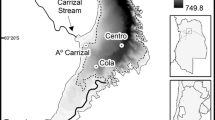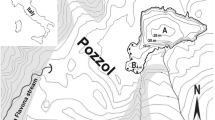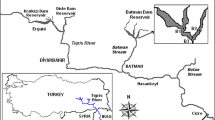Abstract
Trait-based approaches have become increasingly important and valuable in understanding phytoplankton community assembly and composition. These approaches allow for comparisons between water bodies with different species composition. We hypothesize that similar changes in environmental conditions lead to similar responses with regard to functional traits of phytoplankton communities, regardless of trophic state or species composition. We studied the phytoplankton (species composition, community trait mean and diversity) of five reservoirs in Brazil along a trophic gradient from ultra-oligotrophic to meso-eutrophic. Samples at two seasons (summer/rainy and winter/dry) with a horizontal and vertical resolution were taken. Using multivariate analysis, the five reservoirs separated, despite some overlap, according to their environmental variables (mainly total phosphorus, conductivity, pH, chlorophyll a). However, between the seasonal periods, the reservoirs shifted in a similar direction in the multi-dimensional space. The seasonal response of the overall phytoplankton community trait mean differed between the ultra-oligotrophic and the other reservoirs, with three reservoirs exhibiting a very similar community trait mean despite considerable differences in species composition. Within-season differences between different water layers were low. The functional diversity was also unrelated to the trophic state of the reservoirs. Thus, seasonal environmental changes had strong influence on the functional characteristics of the phytoplankton community in reservoirs with distinct trophic condition and species composition. These results demonstrate that an ataxonomic trait-based approach is a relevant tool for comparative studies in phytoplankton ecology.
Similar content being viewed by others
References
Barnett AJ, Finlay K, Beisner BE (2007) Functional diversity of crustacean zooplankton communities: towards a trait-based classification. Freshw Biol 52:796–813
Becker V, Huszar VLM, Naselli-Flores L, Padisák J (2008) Phytoplankton equilibrium phases during thermal stratification in a deep subtropical reservoir. Freshw Biol 53:952–963
CEN (Comité Européen de Normalisation) (2003) Water quality—guidance standard for the routine sampling and pretreatment of benthic diatoms from rivers. EN 13946, Geneva
CEPAGRI (Centro de Pesquisas Meteorológicas e Climáticas Aplicadas à Agricultura) (2016) http://www.cpa.unicamp.br/outras-informacoes/clima-dos-municipios-paulistas.html. Accessed 10 June 2016
Clegg MR, Maberly SC, Jones RI (2004) Dominance and compromise in freshwater phytoplanktonic flagellates: the interactions of behavioral preferences for conflicting environmental gradients. Funct Ecol 18:371–380
Cole G (1983) Textbook of limnology, 3rd edn. The C.V. Mosby Co., London
Conti L, Schmidt-Kloiber A, Grenouillet G, Graf W (2014) A trait-based approach to assess the vulnerability of European aquatic insects to climate change. Hydrobiologia 721:297–315
Crowther TW, Maynard DS, Crowther TR, Peccia J, Smith JR, Bradford MA (2014) Untangling the fungal niche: the trait-based approach. Front Microbiol 5:579
DAEE (Departamento de Águas e Energia Elétrica) (2015) http://www.daee.sp.gov.br/index.php?option=com_content&view=article&id=853:barragens-e-sistema-produtor-alto-tiete&catid=36:programa. Accessed 08 October 2015
Díaz S, Cabido M (2001) Vive la différence: plant functional diversity matters to ecosystem processes. Trends Ecol Evol 15:646–655
Díaz S, Purvis A, Cornelissen JHC, Mace GM, Donoghue MJ, Ewers RM, Jordano P, Pearse WD (2013) Functional traits, the phylogeny of function, and ecosystem service vulnerability. Ecol Evol 3:2958–2975
Edwards KF, Litchman E, Klausmeier CA (2013) Functional traits explain phytoplankton responses to environmental gradients across lakes of the United States. Ecology 94:1626–1635
Flynn KJ, Stoecker DK, Mitra A, Raven JA, Glibert PM, Hansen PJ, Granéli E, Burkholder JM (2013) Misuse of the phytoplankton–zooplankton dichotomy: the need to assign organisms as mixotrophs within plankton functional types. J Plankton Res 35:3–11
Fonseca BM, Bicudo CEM (2008) Phytoplankton seasonal variation in a shallow stratified eutrophic reservoir (Garças Pond, Brazil). Hydrobiologia 600:267–282
Fraisse S, Bormans M, Lagadeuc Y (2013) Morphofunctional traits reflect differences in phytoplankton community between rivers of contrasting flow regime. Aquat Ecol 47:315–327
Golterman HL, Clymo RS (1971) Methods for chemical analysis of freshwaters. International biological program. Blackwell, Oxford
Golterman HL, Clymo RS, Ohmstad MAM (1978) Methods for physical and chemical analysis of freshwaters. International biological programme (Handbook, 8), 2nd edn. Blackwell, Oxford
Hillebrand H, Dürseken CD, Kirschiel D, Pollingher U, Zohary T (1999) Biovolume calculation for pelagic and benthic microalgae. J Phycol 35:403–424
INMET (Instituto Nacional de Meteorologia) (2016) Banco de Dados Meteorológicos para Ensino e Pesquisa (BDMEP). Estação 83781 (Mirante de Santana, SP) http://www.inmet.gov.br/portal/index.php?r=bdmep/bdmep. Accessed 10 June 2016
Kamjunke N, Henrichs T, Gaedke U (2007) Phosphorus gain by bacterivory promotes the mixotrophic flagellate Dinobryon spp. during re-oligotrophication. J Plankton Res 29:39–46
Köppen W (1936) Das geographische system der Klimate. In: Köppen W, Geiger R (eds) Handbuch der Klimatologie, vol 1. Gebrüder Bornträger, Berlin, pp 1–44
Kruk C, Huszar VLM, Peeters ETHM, Bonilla S, Costa L, Lurling M, Reynolds CS, Scheffer M (2010) A morphological classification capturing functional variation in phytoplankton. Freshw Biol 55:614–627
Kruk C, Segura AM, Costa LS, Lacerot G, Kosten S, Peeters E, Huszar VLM, Mazzeo N, Scheffer M (2016) Functional redundancy increases towards the tropics in lake phytoplankton. J Plankton Res. doi:10.1093/plankt/fbw083
Laliberté E, Legendre P (2010) A distance-based framework for measuring functional diversity from multiple traits. Ecology 91:299–305
Lavorel S, McIntyre S, Landsberg J, Forbes TDA (1997) Plant functional classifications: from general groups to specific groups based on response to disturbance. Trends Ecol Evol 12:474–478
Lee RE (2008) Phycology, 4th edn. Cambridge University Press, Cambridge
Litchman E, Klausmeier CA (2008) Trait-based community ecology of phytoplankton. Annu Rev Ecol Syst 39:615–639
Longhi ML, Beisner BE (2010) Patterns in taxonomic and functional diversity in lake phytoplankton. Freshw Biol 55:1349–1366
Lopes MRM, Bicudo CEM, Ferragut C (2005) Short term spatial and temporal of phytoplankton in a shallow tropical oligotrophic reservoir, southeast Brazil. Hydrobiologia 542:235–247
Mackereth FJH, Heron J, Talling JF (1978) Water analysis: some revised methods for limnologists. Freshwater Biological Association, Scientific Publication, 36. Titus Wilson & Son Ltd, Kendall
Magurran AE (2004) Measuring biological diversity. Blackwell Science, Oxford
McCune BMJ, Mefford MJ (2011) PC-ORD Multivariate analysis of ecological data. Version 6.0. MJM software. Gleneden Beach, Oregon
McGill BJ, Enquist BJ, Weiher E, Westoby M (2006) Rebuilding community ecology from functional traits. Trends Ecol Evol 21:178–185
Mitra A, Flynn KJ, Tillmann U, Raven JA, Caron D, Stoecker DK, Not F, Hansen PJ, Hallegraeff G, Sanders R, Wilken S, McManus G, Johnson M, Pitta P, Vage S, Berge T, Calbet A, Thingstand F, Jeong HJ, Burkholder J, Gilbert PM, Granéli E, Lundgren V (2016) Defining planktonic protist functional groups on mechanisms for energy and nutrient acquisition: incorporation of diverse mixotrophic strategies. Protist 167:106–120
Moraes J, Carvalho JP, Carlstrom Filho AA (2005) Caracterização e evolução do uso das terras na sub-bacia Tietê-Cabeceiras. Report project Negowat, p 11
Naselli-Flores L (2000) Phytoplankton assemblages in twenty-one Sicilian reservoirs: relationships between species composition and environmental factors. Hydrobiologia 424:1–11
Padisák J, Crossetti LO, Naselli-Flores L (2009) Use and misuse in the application of the phytoplankton functional classification: a critical review with updates. Hydrobiologia 621:1–19
Pálffy K, Présing M, Vörös L (2013) Diversity patterns of trait-based phytoplankton functional groups in two basins of a large, shallow lake (Lake Balaton, Hungary) with different trophic state. Aquat Ecol 47:195–210
Petchey OL, Gaston KJ (2002) Functional diversity (FD), species richness, and community composition. Ecol Lett 5:402–411
Porat R, Teltsch B, Perelman A, Dubinsky Z (2001) Diel buoyancy changes by the cyanobacterium Aphanizomenon ovalisporum from a shallow reservoir. J Plankton Res 23:753–763
R Core Team (2013) R: a language and environment for statistical computing. R Foundation for Statistical Computing, Vienna
Reynolds CS, Huszar V, Kruk C, Naselli-Flores L, Melo S (2002) Towards a functional classification of the freshwater phytoplankton. J Plankton Res 24:417–428
SABESP (Companhia de Saneamento Básico do Estado de São Paulo) (2015) http://site.sabesp.com.br/site/interna/Default.aspx?secaoId=36. Accessed 07 October 2015
Santana LM, Crossetti LO, Ferragut C (2017) Ecological status assessment of tropical reservoirs through the assemblage index of phytoplankton functional groups. Braz J Bot. doi:10.1007/s40415-017-0373-4
Santos AMC, Carneiro FM, Cianciaruso MV (2015) Predicting productivity in tropical reservoirs: the roles of phytoplankton taxonomic and functional diversity. Ecol Indic 48:428–435
Sartory DP, Grobbelaar JU (1984) Extraction of chlorophyll a from freshwater phytoplankton for spectrophotometric analysis. Hydrobiologia 114:177–187
Solorzano L (1969) Determination of ammonia in natural waters by the phenolhypochlorite method. Limnol Oceanogr 14:799–801
Strickland JDH, Parsons TR (1960) A manual of sea water analysis. Bull Fish Res Board Can 125:1–185
Sun J, Liu D (2003) Geometric models for calculating cell biovolume and surface area for phytoplankton. J Plankton Res 25:1331–1346
Tilman D (2001) Functional diversity. In: Levins SA (ed) Encyclopedia of biodiversity. Academic, San Diego, pp 109–120
Utermöhl H (1958) Zur Vervolkomnung der quantitative Phytoplankton-Methodik. Mitt Int Ver Theor Angew Limnol 9:1–38
Valderrama GC (1981) The simultaneous analysis of total nitrogen and total phosphorus in natural waters. Mar Chem 10:109–122
Verheyen K, Honnay O, Motzkin G, Hermy M, Foster DR (2003) Response of forest plant species to land-use change: a life-history trait-based approach. J Ecol 91:563–577
Villéger S, Mason NWH, Mouillot D (2008) New multidimensional functional diversity indices for a multifaceted framework in functional ecology. Ecology 89:2290–2301
Violle C, Navas ML, Vile D, Kazakou E, Fortunel C, Hummel I, Garnier E (2007) Let the concept of trait be functional! Oikos 116:882–892
Vogt RJ, Beisner BE, Prairie YT (2010) Functional diversity is positively associated with biomass for lake diatoms. Freshw Biol 55:1636–1646
Weithoff G (2003) The concepts of ‘plant functional types’ and ‘functional diversity’ in lake phytoplankton—a new understanding of phytoplankton ecology? Freshw Biol 48:1669–1675
Weithoff G, Gaedke U (2016) Mean functional traits of lake phytoplankton reflect seasonal and inter-annual changes in nutrients, climate and herbivory. J Plankton Res. doi:10.1093/plankt/fbw072
Weithoff G, Rocha MR, Gaedke U (2015) Comparing seasonal dynamics of functional and taxonomic diversity reveals the driving forces underlying phytoplankton community structure. Freshw Biol 60:758–767
Winder M, Reuter JE, Schladow SG (2009) Lake warming favours small-sized planktonic diatom species. Proc R Soc B 276:427–435
Acknowledgements
L. M. S. was supported by Fundação de Amparo à Pesquisa do Estado de São Paulo (FAPESP) with a doctoral fellowship (Grant No. 2011/24000-4). This work was carried out within the framework of the AcquaSed project also supported by funds from FAPESP (Grant No. 2009/53898–9). We thank especially Dra. Angélica C. Righetti da Rocha for her help and efforts in the limnological and diatom database. We deeply appreciate the assistance of personnel from the agency in charge São Paulo’s public water supply—SABESP/RHMS (Companhia de Saneamento do Estado de São Paulo, Divisão de Recursos Hídricos Metropolitanos Sudoeste) for their valuable logistical support during the fieldwork. We also thank all students and technicians from Laboratório de Ecologia Aquática, Instituto de Botânica, involved in the laboratory and fieldwork.
Author information
Authors and Affiliations
Corresponding author
Additional information
Handling Editor: Miquel Lurling.
Electronic supplementary material
Below is the link to the electronic supplementary material.
Rights and permissions
About this article
Cite this article
Santana, L.M., Weithoff, G. & Ferragut, C. Seasonal and spatial functional shifts in phytoplankton communities of five tropical reservoirs. Aquat Ecol 51, 531–543 (2017). https://doi.org/10.1007/s10452-017-9634-3
Received:
Accepted:
Published:
Issue Date:
DOI: https://doi.org/10.1007/s10452-017-9634-3








